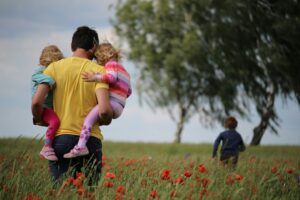Autumn 2024

Self-awareness and self-compassion are the foundational steps toward self-care. A well-cared-for Self creates a strong, flexible footing for sensitive awareness and responsiveness as we care for our families or Early Childhood classes. If you practice meditation already, you are familiar with the deep sense of self-care it offers. Self- care is the basis of care for others. Remember what the flight attendant tells us on every flight: Put on your own oxygen mask before helping others.
Let’s also remember Rudolf Steiner’s first advice for those working with children. “Be a person worthy of the child’s imitation.” We become worthy of our children’s imitation when we strive toward compassion, which always begins with self-compassion. We do this by working with intention, time, space, and form.
—first make a clear and focused intention to practice self-care
—then make time: choose a time of day that you can consistently turn toward self-care
—make space: will this be indoors or outdoors, in the kitchen or the garden….
—decide a form: will you choose to consciously breathe, walk, cook, garden….?
We make an inner intention and then arrange our outer life to support this inner striving.
In his straightforward, beautiful book, How God Changes Your Brain, neuroscientist Andrew Newberg says, according to his research and that of others, to increase a felt-experience of self-compassion and peace through the activation of the anterior cingulate (the angel lobes)
“Simply focus on compassion or an image of peace as you breathe deeply and relax. Hold this thought for twelve minutes each day and in a matter of a few months you’ll begin to build and strengthen new neural circuits of compassion…. To establish empathy and serenity you simply need to absorb yourself in memories associated with the feelings of kindness and love. If you consciously interrupt pessimistic thoughts and feelings with optimistic beliefs . . . you will stimulate your anterior cingulate. Fear, anxiety, and irritability will decrease and a sense of peacefulness will slowly take its place. It is a simple seesaw effect. Love goes up and fear goes down. Anger goes up and compassion goes down. The choice is entirely yours”.

The choice is wholly ours: We can choose self-care and thereby make new neural pathways of compassion. Three interconnecting principles that can be distilled from most of the world’s spiritual practices are Intention, Relaxation, and Awareness. These can be a foundation for us as we explore self-care. Let’s look at a few activities that we do every day and imagine what our family or classroom life can be when we bring intention, relaxation, and awareness to them.
Simple activities in which we practice Intention, Relaxation, and Awareness:
Walking: It is rare to walk with awareness; usually our thoughts run out ahead of us. Think of at least one time each day you can slow your pace, relax, listen to the rhythm of your footsteps, and become present in your body. Choose a time ~ maybe on the way to the mailbox ~ and bring awareness and relaxation to your gait. Sometimes you will remember, sometimes not. When you do remember, let yourself feel the reward of pleasure and the goodness of being aware and in a human body.
 Cooking: Preparing the evening meal can be stressful. Give your child a hearty afternoon snack of veggies and protein to offset crankiness. Slow your pace and turn your attention to the lovely food in front of you. Slowly chop the red peppers, while close beside your children nibble as many carrot spears as they cut. Breathe in the sweet tang of peppers, the deep sweetness of the carrots. Listen to the sizzle of the onions and garlic cooking on the stove. Choose one meal or perhaps one snack that you prepare each day, and bring yourself to awareness and relaxation.
Cooking: Preparing the evening meal can be stressful. Give your child a hearty afternoon snack of veggies and protein to offset crankiness. Slow your pace and turn your attention to the lovely food in front of you. Slowly chop the red peppers, while close beside your children nibble as many carrot spears as they cut. Breathe in the sweet tang of peppers, the deep sweetness of the carrots. Listen to the sizzle of the onions and garlic cooking on the stove. Choose one meal or perhaps one snack that you prepare each day, and bring yourself to awareness and relaxation.

Cleaning: Try cleaning with gratitude instead of grim determination. I can hear you laughing as you read this; try it, please! Ready yourself with a song. Hum a few rounds and remind yourself how grateful you are— maybe not necessarily for the chore, but for your children, their laughter, your spouse, their support, and yes, even for all the mess this circle of love creates. This is a wonderful way to experience the miracle of inner speech—gently prod yourself toward gratitude; sing and feel a little smile forming; feel your heart growing brighter and the load lighter. Sometimes I laugh at myself for being led toward happiness so easily.
Breathing, Walking, Cooking, Cleaning
These are simple activities that we do every day of our life. They are opportunities to devote twelve minutes to care for our self while caring for our family or class. It is our consciousness alone—the use of our heart and the prefrontal cortex—that determines the quality of these everyday events. We can aim for the stars; we can guide our self toward high ideals right in the middle of a very commonplace ordinary day. Amid good food and squabbles, stories and diapers, we can build a new future. We do it right here, exactly where we are One Breath at a Time.

